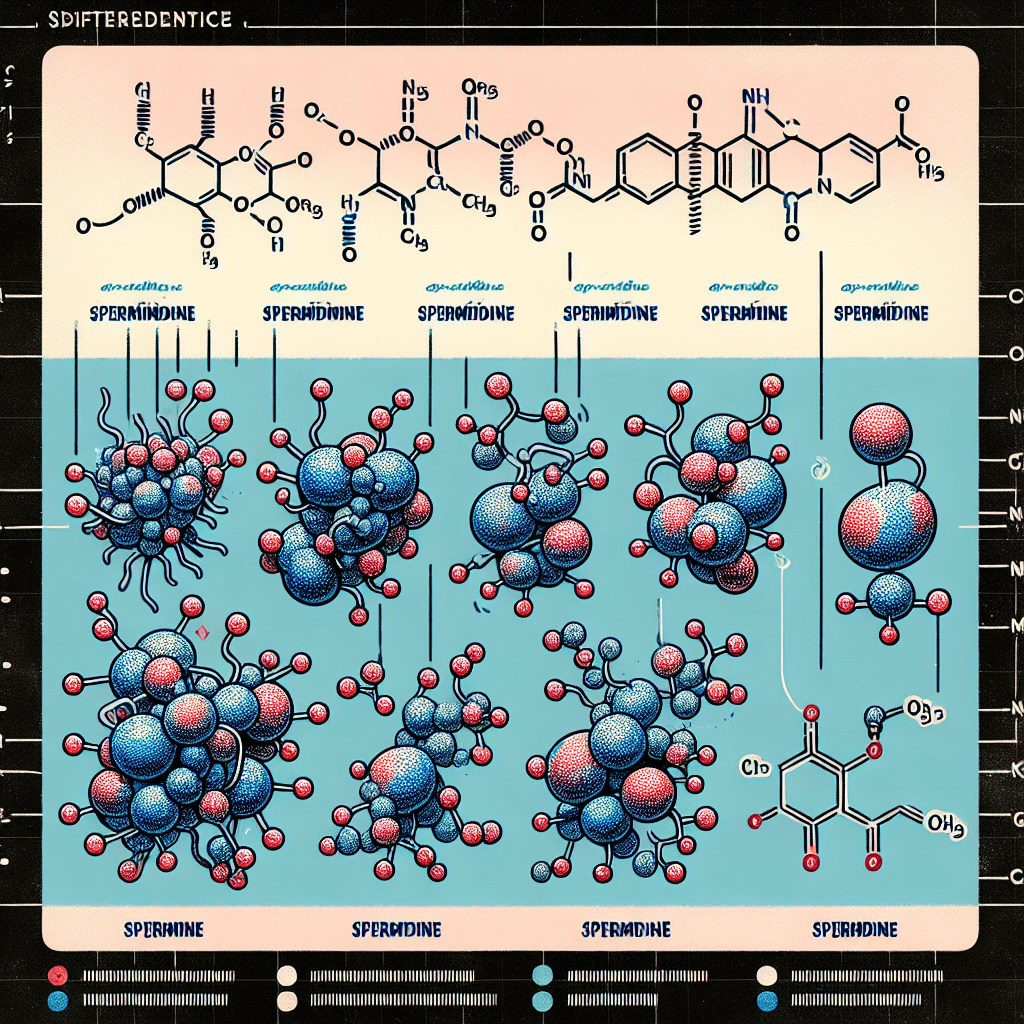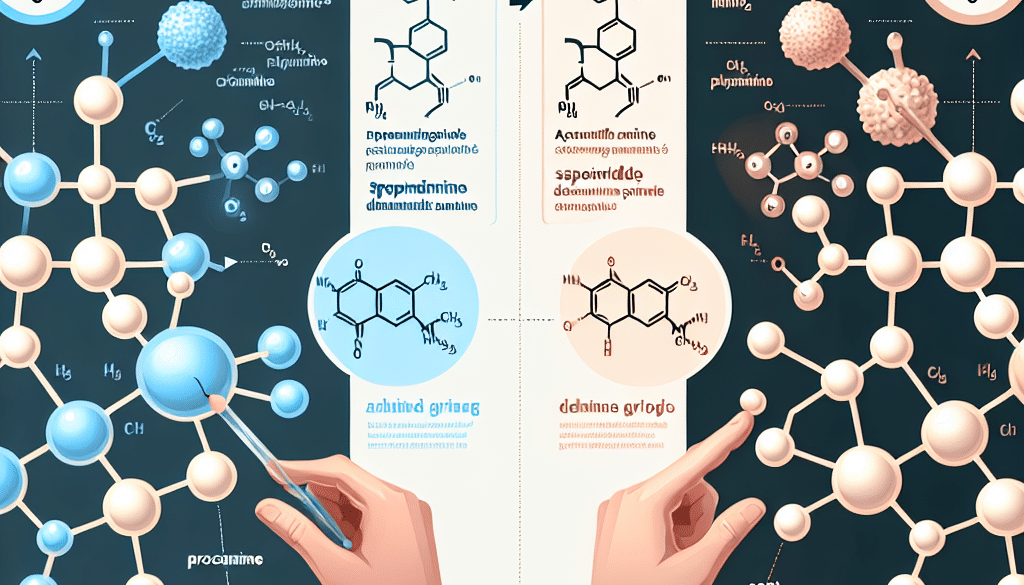Spermine and Spermidine: Differences
-
Table of Contents
- Spermine and Spermidine: Exploring Their Unique Differences
- Understanding Polyamines: Spermine and Spermidine
- Biosynthesis of Spermine and Spermidine
- Biological Functions of Spermine and Spermidine
- Distinct Roles and Health Implications
- Spermidine and Longevity
- Spermine and Cellular Metabolism
- Therapeutic Potential and Applications
- Spermidine in Disease Prevention
- Spermine in Clinical Settings
- Dietary Sources and Supplementation
- Conclusion: Key Takeaways on Spermine and Spermidine
- Enhance Your Health with ETprotein’s Premium Protein Products
Spermine and Spermidine: Exploring Their Unique Differences

Within the intricate web of biological molecules that sustain life, polyamines like spermine and spermidine play crucial roles. Despite their similar names and related functions, these two compounds have distinct characteristics and implications for health and disease. This article delves into the differences between spermine and spermidine, exploring their biosynthesis, biological functions, and potential health benefits, supported by relevant examples, case studies, and statistics.
Understanding Polyamines: Spermine and Spermidine
Polyamines are organic compounds that contain multiple amino groups. They are ubiquitous in living organisms and are involved in various cellular processes. Spermine and spermidine are two of the most well-known polyamines, and while they share some common pathways and functions, they also exhibit unique properties.
Biosynthesis of Spermine and Spermidine
The biosynthesis of spermine and spermidine is a tightly regulated process that begins with the amino acid ornithine. Through a series of enzymatic reactions, ornithine is converted into putrescine, which then serves as a precursor for the synthesis of spermidine and spermine.
- Putrescine to Spermidine: Putrescine undergoes a reaction with S-adenosylmethionine (SAM) to form spermidine.
- Spermidine to Spermine: Spermidine is further converted into spermine through another reaction with SAM.
The balance between these polyamines is critical for cellular homeostasis, and disruptions in their levels can lead to various health issues.
Biological Functions of Spermine and Spermidine
Both spermine and spermidine are involved in essential cellular functions such as:
- Stabilizing DNA and RNA structures
- Regulating gene expression
- Modulating enzyme activities
- Protecting cells from oxidative stress
However, spermine is generally found in higher concentrations within cells and has a stronger affinity for nucleic acids than spermidine. This difference in affinity can influence the specific roles each polyamine plays in cellular processes.
Distinct Roles and Health Implications
While both spermine and spermidine are vital for life, research has uncovered distinct roles and health implications for each polyamine.
Spermidine and Longevity
Studies have shown that spermidine has a significant impact on longevity and age-related diseases. It promotes autophagy, a process where cells recycle their components, which is crucial for cellular rejuvenation and the prevention of age-related decline.
- A study published in Nature Cell Biology demonstrated that spermidine supplementation extended the lifespan of yeast, flies, worms, and human immune cells.
- Research in humans has correlated higher dietary intake of spermidine with reduced blood pressure and a lower risk of cardiovascular disease.
Spermine and Cellular Metabolism
Spermine is particularly important for cellular metabolism and the modulation of ion channels. Its role in cellular metabolism includes:
- Regulating the function of mitochondria, the cell’s powerhouses
- Influencing the metabolism of nitric oxide, a critical signaling molecule
Moreover, spermine levels have been associated with the body’s response to stress and inflammation, with potential implications for diseases such as cancer.
Therapeutic Potential and Applications
The unique properties of spermine and spermidine have led to interest in their therapeutic potential for various health conditions.
Spermidine in Disease Prevention
Spermidine’s role in autophagy and cellular protection suggests it may be beneficial in preventing neurodegenerative diseases like Alzheimer’s and Parkinson’s. Its potential applications include:
- Neuroprotective therapies
- Cardioprotective supplements
- Anti-aging products
Spermine in Clinical Settings
Spermine’s influence on cellular metabolism and ion channels has been explored in clinical settings for:
- Treating metabolic disorders
- Developing cancer therapies
- Improving recovery from ischemic events such as strokes
Dietary Sources and Supplementation
Both spermine and spermidine are found in a variety of dietary sources. Foods rich in these polyamines include:
- Aged cheese
- Mushrooms
- Whole grains
- Legumes
- Meat products
Supplementation with spermidine and spermine is also available, and ongoing research continues to explore the optimal dosages and formulations for health benefits.
Conclusion: Key Takeaways on Spermine and Spermidine
In summary, spermine and spermidine are polyamines with distinct biosynthetic pathways, biological functions, and health implications. Spermidine has been linked to longevity and the prevention of age-related diseases, while spermine plays a critical role in cellular metabolism and stress response. Both compounds have therapeutic potential and are available through dietary sources and supplements.
Enhance Your Health with ETprotein’s Premium Protein Products
If you’re looking to incorporate high-quality protein into your diet, ETprotein offers a range of organic bulk vegan proteins that can complement your intake of polyamines like spermine and spermidine. Their products are characterized by a neutral taste, non-GMO, allergen-free attributes, and cater to various industries, including nutraceuticals and sports nutrition.
For those interested in the health benefits of spermine and spermidine, incorporating ETprotein’s protein products into your diet can be a valuable addition to a balanced and health-focused lifestyle.
About ETprotein:
ETprotein, a reputable protein and L-(+)-Ergothioneine (EGT) Chinese factory manufacturer and supplier, is renowned for producing, stocking, exporting, and delivering the highest quality organic bulk vegan proteins and L-(+)-Ergothioneine. They include Organic rice protein, clear rice protein, pea protein, clear pea protein, watermelon seed protein, pumpkin seed protein, sunflower seed protein, mung bean protein, peanut protein, and L-(+)-Ergothioneine EGT Pharmaceutical grade, L-(+)-Ergothioneine EGT food grade, L-(+)-Ergothioneine EGT cosmetic grade, L-(+)-Ergothioneine EGT reference grade and L-(+)-Ergothioneine EGT standard. Their offerings, characterized by a neutral taste, non-GMO, allergen-free attributes, with L-(+)-Ergothioneine purity over 98%, 99%, cater to a diverse range of industries. They serve nutraceutical, pharmaceutical, cosmeceutical, veterinary, as well as food and beverage finished product distributors, traders, and manufacturers across Europe, USA, Canada, Australia, Thailand, Japan, Korea, Brazil, and Chile, among others.
ETprotein specialization includes exporting and delivering tailor-made protein powder and finished nutritional supplements. Their extensive product range covers sectors like Food and Beverage, Sports Nutrition, Weight Management, Dietary Supplements, Health and Wellness Products, and Infant Formula, ensuring comprehensive solutions to meet all your protein needs.
As a trusted company by leading global food and beverage brands and Fortune 500 companies, ETprotein reinforces China’s reputation in the global arena. For more information or to sample their products, please contact them and email sales(at)ETprotein.com today.












